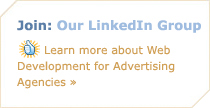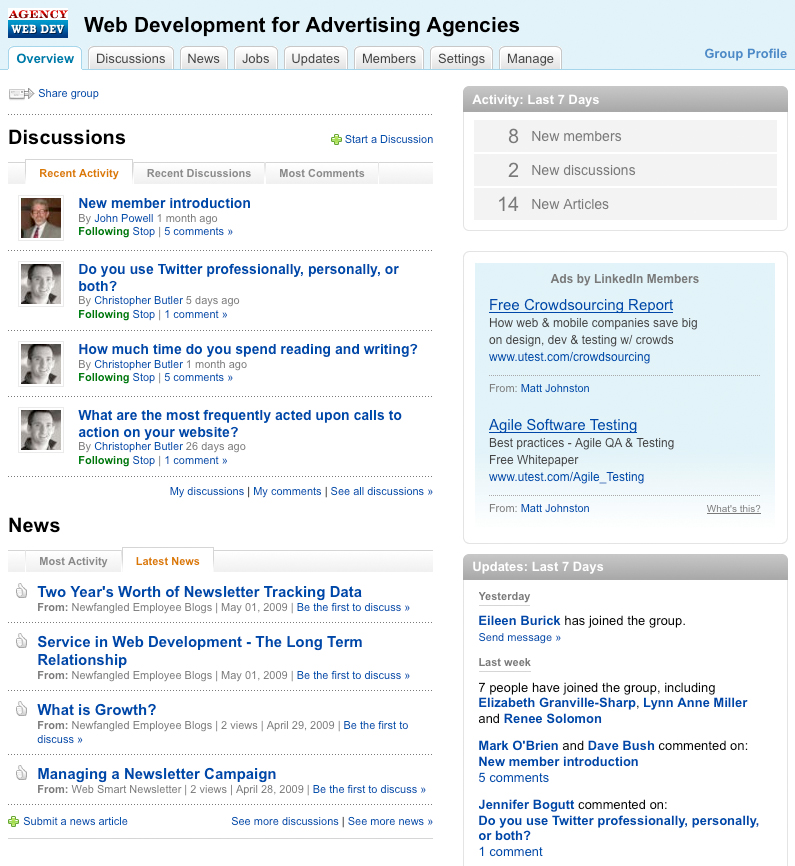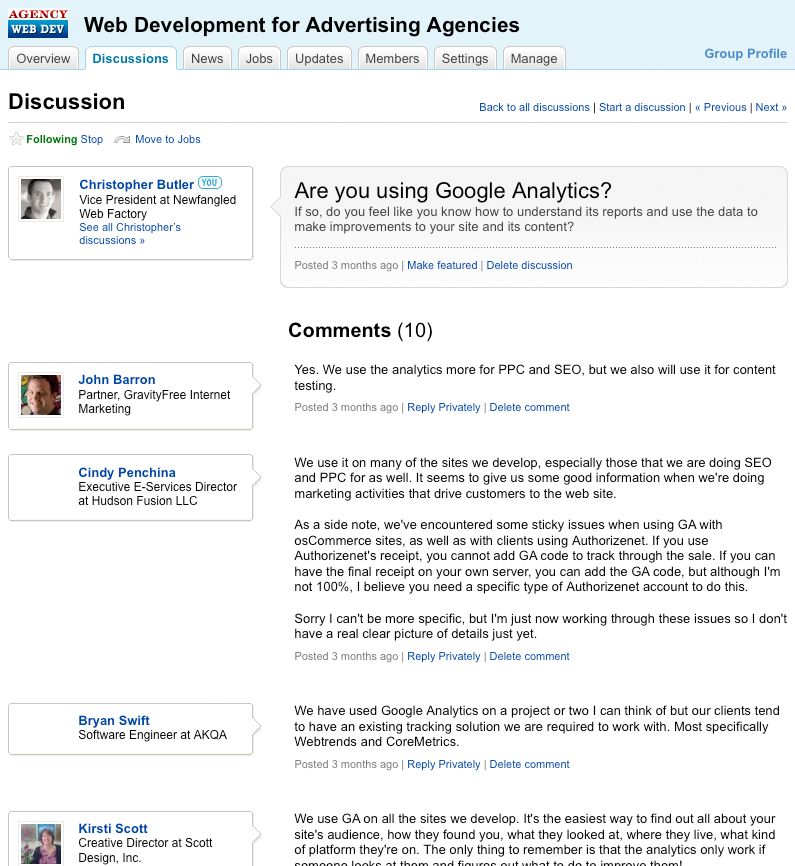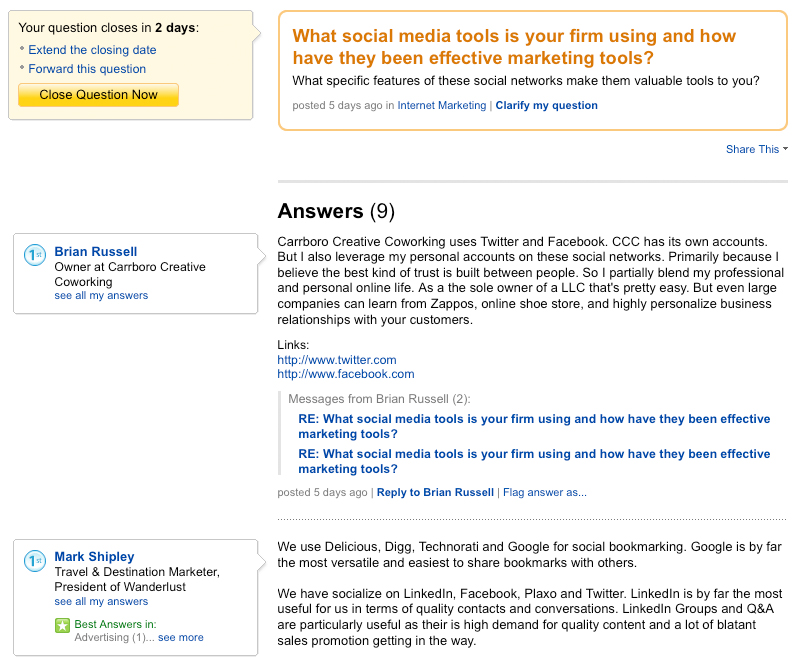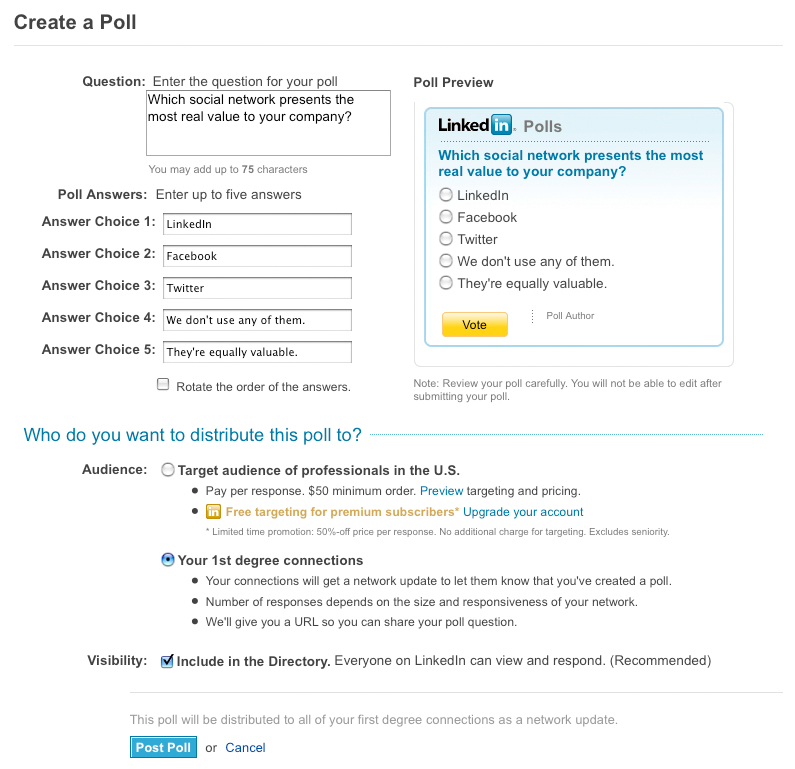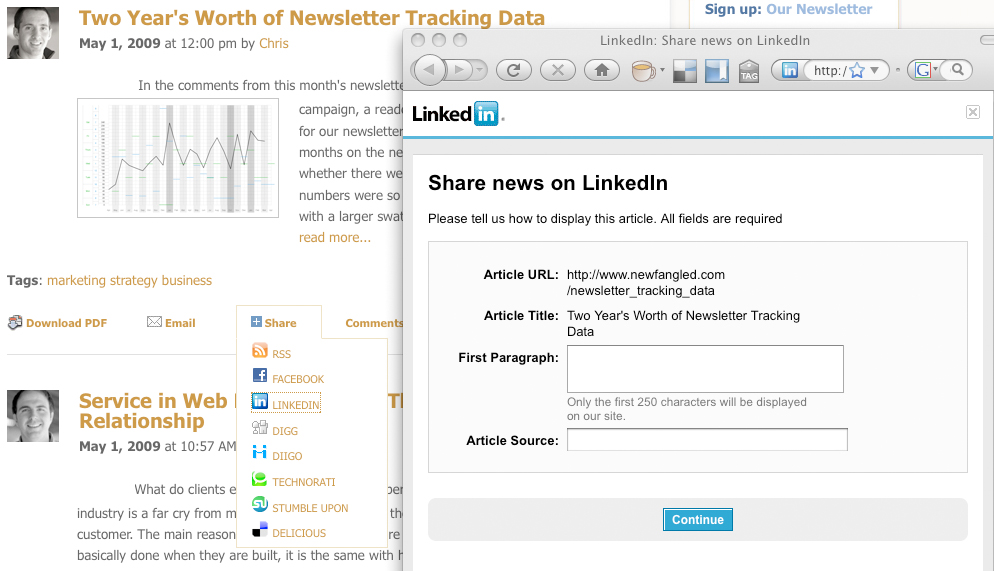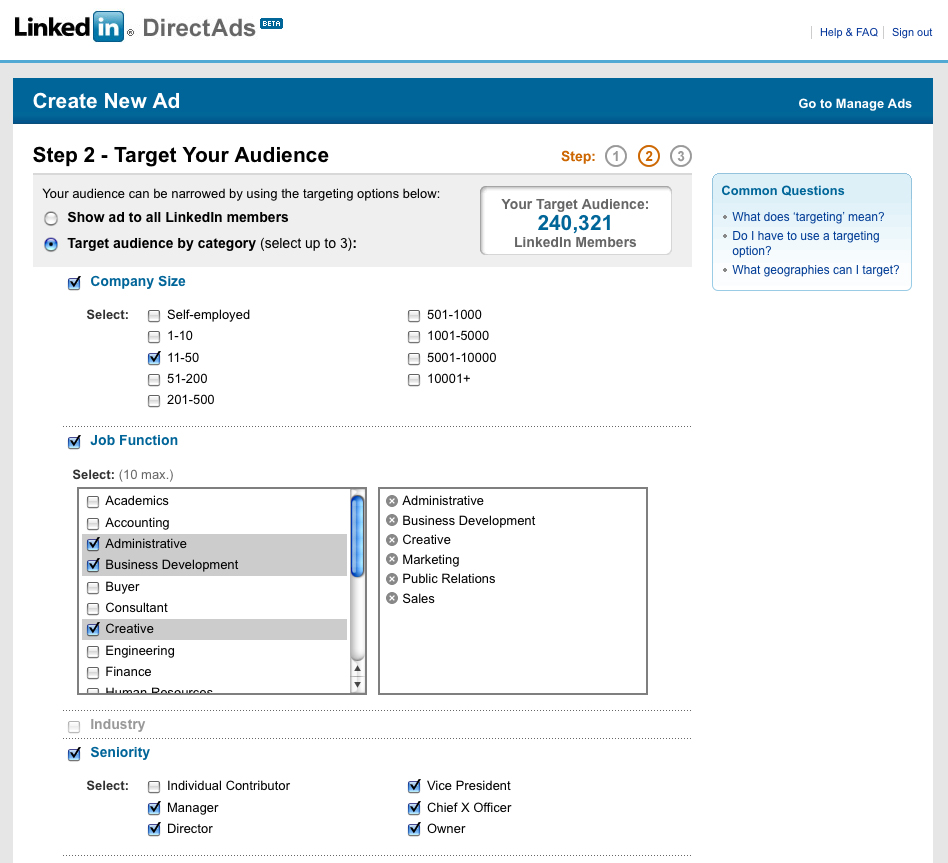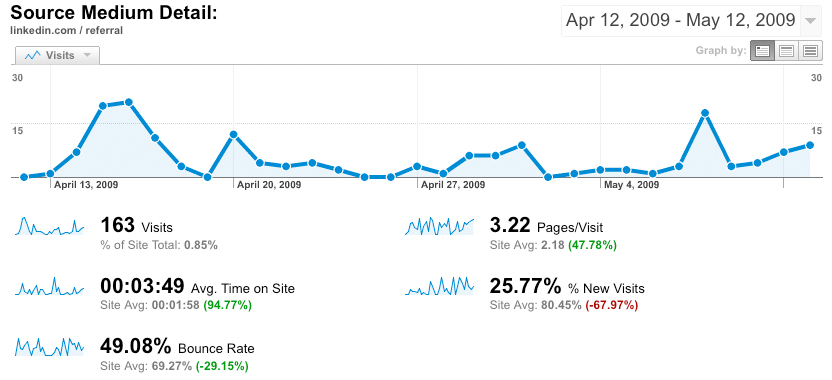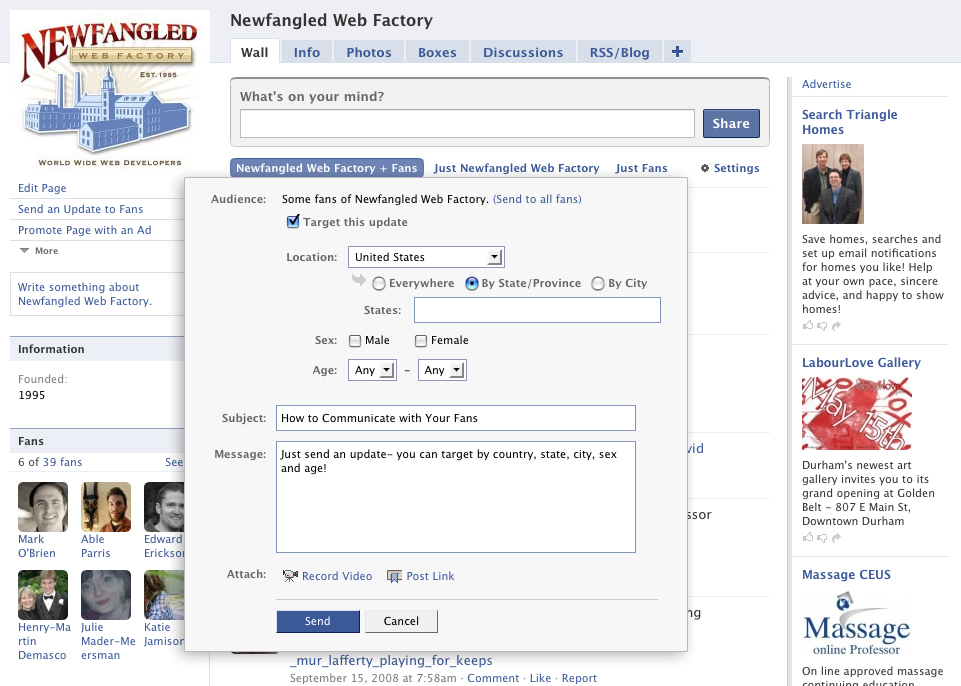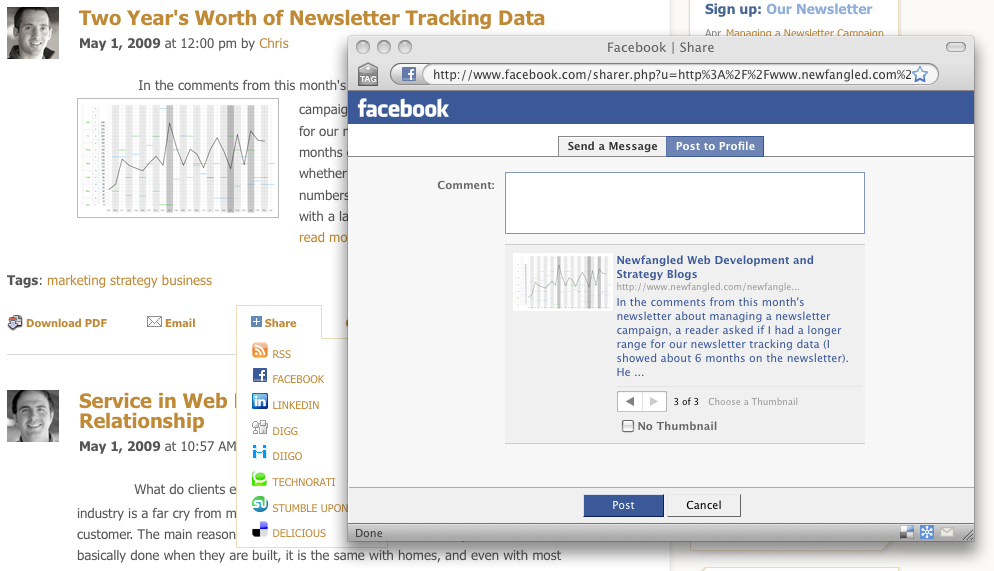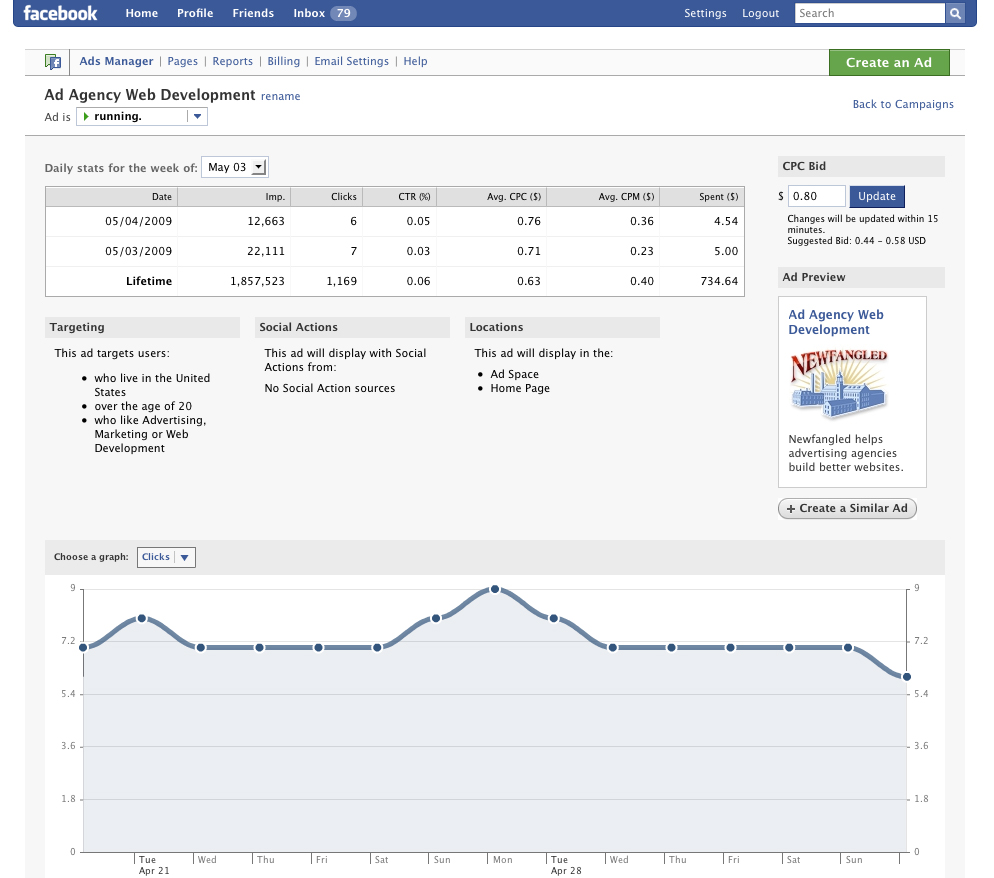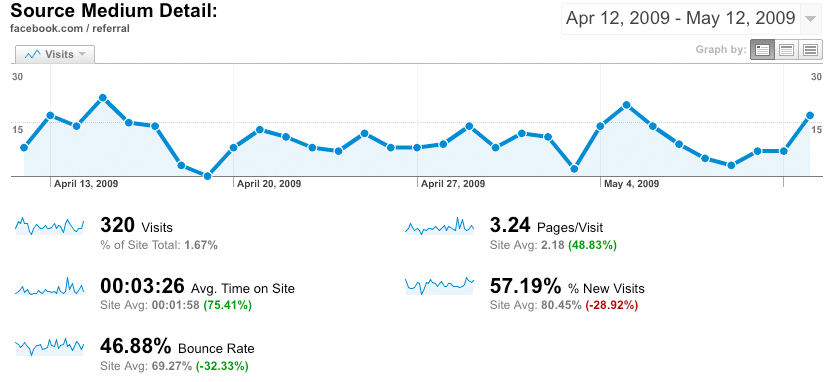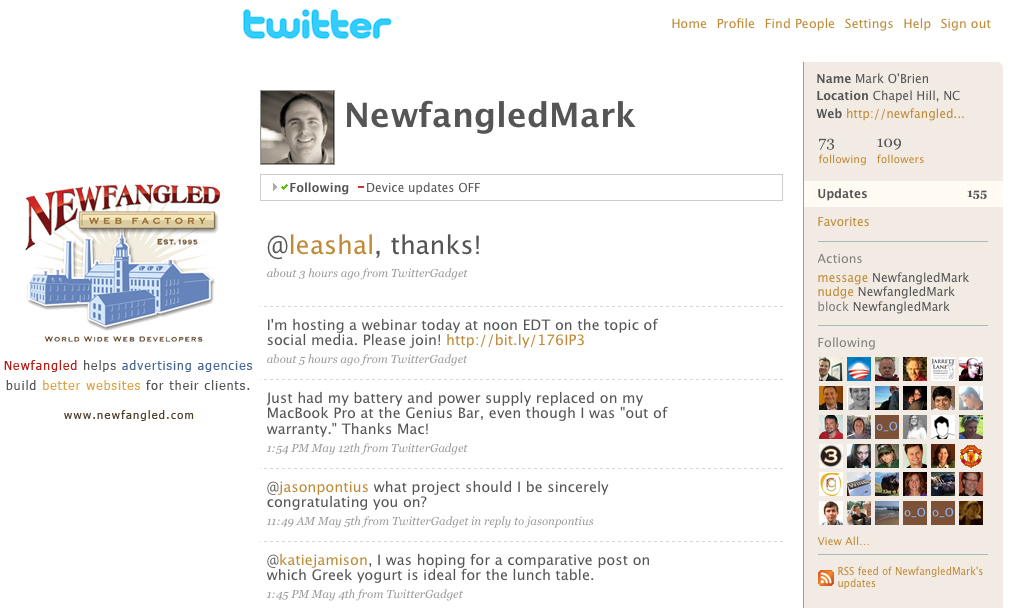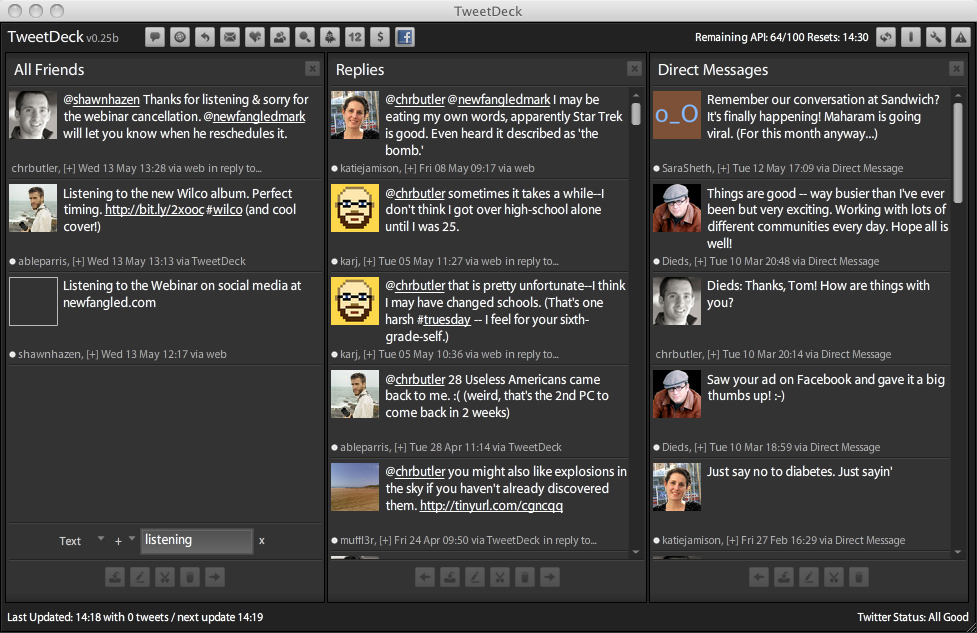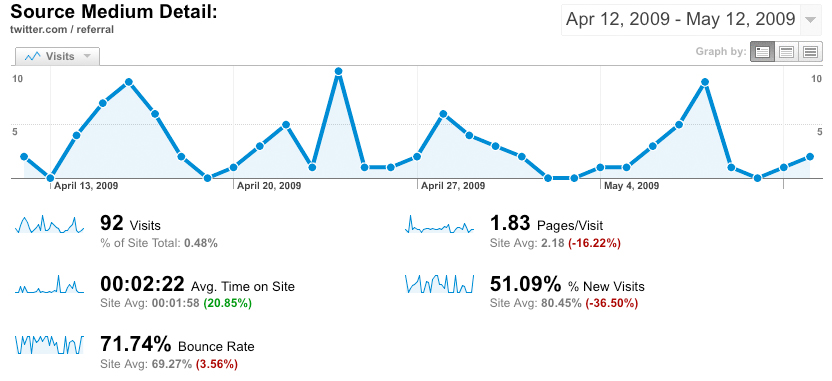Social media is no longer a novelty. With the number of users of various social networks rising to pretty astonishing levels (Facebook, for example, has 200 million active users globally), it’s clear that we’ve reached a point where social media has been well integrated into contemporary human culture. Now, the trick for all of us is how to practically integrate social media into how we operate professionally, which I expect will be at times fun, confusing, challenging, frustrating, and exhausting. Why? Because it requires that we get much more public than we’ve probably ever been as professionals and share more of ourselves than we’re used to, and ultimately, that we adopt new tools and add a few more tasks to our already full days. Does this mean that you need to hire a “Social Media Manager”? No (I, for one, wouldn’t want my role to be based upon a tool). But does integrating social media need to be part of someone’s job description? Absolutely.
Each page of this month’s newsletter is a bit longer than normal, and includes many screenshots. Every screenshot can be clicked to open the full-size version in case you’d like to get a closer look at the details.
LinkedIn is, in my opinion, the most important business-oriented social network on the web. Eric wrote a bit about LinkedIn two years ago in our May, 2007 newsletter about social media, noting that its answers and recommendations functionality were valuable tools for sharing expertise and networking. Since then, LinkedIn has continued to expand its capabilities, some of which I will discuss below. While Facebook and Twitter have been more in the limelight, LinkedIn has been quietly refined and shaped into a very impressive platform. (If you’d like to connect with me on LinkedIn, here’s a link to my LinkedIn profile.)
LinkedIn Groups
We decided to set up a LinkedIn group back in December, both to connect people in and around our network of agencies and developers and to start discussions through which we could share our expertise in web development. Because we’ve clearly positioned ourselves as a web development firm that helps advertising agencies build better websites for their clients, we named our group “Web Development for Advertising Agencies.” Leaving our actual name, Newfangled, out of the group’s name was intentional: while we consider the time we devote to the group part of our investment in marketing for Newfangled, we believe that freely sharing our expertise in a group set up to not only serve us will ultimately benefit us in addition to everyone else involved. An educated prospect always makes a better client. We invited some clients and contacts to join the group and began adding discussions and news items to make sure there was some worthwhile content available to those who joined right away. Since then, our group’s roster has increased to over 200 members and continues to grow.
We also added a call to action to our website (shown to the left) inviting users to join the group. If you haven’t already, go ahead and click it to join today- we’d love to have you among our members.
In the screenshot below, you’ll see how LinkedIn has created a well-designed landing page for its groups, showing recent discussions and news items (on the left), as well as a quick synopsis of the last week of activity (on the right). Most of the discussions and news items are still coming from us, rather than other members, but just like any group, we expect that at least some current lurkers will eventually convert to active members.
Below is a screenshot of an individual discussion that I started prior to writing our January newsletter on how to use Google Analytics. Anyone who has joined the group will get an alert when a new discussion is started, and then can respond to it by posting to the thread if they want to. Like I do with LinkedIn’s answers and polls functionality (more on those later), I like to use discussions as an initial approach to my newsletter writing. By asking a question like the one below, I can quickly get a sense for how the people in our network (likely readers of our newsletter) feel about a particular topic and shape my writing to be more helpful to them.
Setting up a group like this is not something that you’re going to be able to measure the value of, at least not very precisely, until you actually sign a new client from among its members. But that aside, it’s better to consider your LinkedIn group as you might an opportunity to attend or sponsor a conference; the benefits of being among a large group of industry practitioners are many, even if you’re not there to sell something. So, in choosing its name, you should be implicitly positioning and narrowing the focus of your group so that after your initial invitations, it appropriately curates its own membership. Our goal is to work with agencies, so naming our group “Web Development for Advertising Agencies” was intended to help keep the membership from being disproportionately comprised of competitors rather than potential clients.
LinkedIn Q & A
As I mentioned earlier, I like to tap in to my LinkedIn network to gather information and make an “initial approach” to my upcoming newsletters. One of the best ways I have found to do this has been to use LinkedIn’s ‘Answers’ section to submit a question that can be viewed and answered by any user. You can add an explanation to expand upon your question, categorize it, and then send it to up to 200 people in your network. I’ve gotten in the habit of doing this before each newsletter I write, and the answers I receive serve as a decent barometer for the public sentiment toward whatever concept I have asked about. In preparation for this month’s newsletter, for example, I asked What social media tools is your firm using and how have they been effective marketing tools? In the screenshot below, you can see how your question will appear to LinkedIn users and how the various responses you might get will cascade in the thread.
By the way, did you know that your LinkedIn question’s page is indexable by search engines? This is a great opportunity to continue to build your authority on those subjects that matter to your firm and point back to your website. For example, after posting my question, Is tracking visitors to your website ethical?, I created a blog post linking to it and made sure that I promoted the question on various other channels, including Facebook, StumbleUpon, Undrln, Tumblr, etc. One of our employees also linked to it on Reddit. The benefit of all of this is that if I search for that question, my question and links to it dominate the search results page (see image to the left). I do realize that few users will search for my question verbatim, but if I generalize the search to something like “website tracking ethics,” my question still comes up fairly high on the first page.
You can also create polls with LinkedIn and categorize and send them to people in your network. As you can see from the screenshot below, they’re very simple to set up. Just like the answers functionality, this would be another great opportunity to get information from your network in advance of any writing you might do. The poll shown below, which asks ‘Which social network presents the most real value to your company?’. I was impressed with some of the visual reports that let you see the poll results from different perspectives. For example, if I want to re-organize the results visually by the job title, job function, company size, age or gender of the respondents, I can do that. After the first day of this poll being open, I wrote a blog post about using LinkeIn polls. Though the numbers have changed quite a bit since, LinkedIn is still, by far, valued at the top.
Sharing Website Content on LinkedIn
I’ve already written quite a bit about how to use LinkedIn as a satellite platform to your website, but it’s also very important to make sure that you provide a means for your readers to share your content on LinkedIn. We’ve built in a general sharing tool that sits beneath all of our blog and newsletter content that lets our readers easily share our content on a variety of different social networks. LinkedIn provides some really nice sharing code, which, when implemented, links to the pop-up screen shown below. What I really appreciate is that if I share an article among one group that I’m a part of on LinkedIn, I can easily re-share it with a different group without having to repeat the entire sharing process.
Advertising on LinkedIn
In a sense, simply using LinkedIn in the ways I’ve described so far is already potential free advertising, but you can also set up paid, targeted advertising on LinkedIn. In the screenshot below, I’m showing the advertisement setup screen, which allows you to target your audience by various means, including company size, job function, industry, and seniority. As you can see, we’ve set up our ad to appear to management-level users working for mid-sized (11-50) companies in administrative, new business or creative roles. As you narrow your selection, LinkedIn displays a counter inline that shows how large your audience potentially is. In this case, our targeted ad could potentially be seen by 240,321 different LinkedIn users.
Referral Traffic from LinkedIn
In general, it’s better to measure success as far as traffic is concerned by potency, not volume. For instance, we get many more visitors from search engines like Google to our blog posts than from specific social networks, but as a group, that traffic has a fairly high bounce rate. This is something I’ve discussed in previous newsletters, specifically in How to Use Google Analytics, but suffice it to say that for some companies, having a high bounce rate for some content isn’t the end of the world. However, for certain sources of traffic, particularly LinkedIn, I would expect to have fewer visitors but a lower bounce rate among them. As you can see from the screenshot below, we received 163 unique visits over the course of one month from LinkedIn users. This is not a huge number by any means, but notice that the average time on site is almost 4 minutes. Also, the average number of pages each visitor sees is over 3, and the bounce rate is under 50%. Not bad! What we see here is a smaller, more focused audience.
Next, we’ll take a closer look at Facebook.
My opinion of Facebook has changed quite a bit over the past few years. I began with a general level of skepticism and resisted joining for a long while. Eventually, I set up an account and slowly started to use it more. It was fun to reconnect with people I hadn’t spoken to in a long time, and it actually became a great way to keep up with family. I used it to share a ton of content that I ran across throughout my day, including blog posts and newsletter content from Newfangled. Although I did connect with many people within my professional network, my interactions with them never reached the level of frequency or importance of those on LinkedIn. At this point, I think it’s a good idea to be on Facebook as an individual, as well as to set up a page for your company, to make sure that your content is sharable among its users. However, Facebook does not compare in terms of the helpful business-related functionality offered by LinkedIn. This, of course, may change, which is why I’m not at all suggesting that you ignore Facebook. To the contrary, maintaining company pages, sharing functionality, and even advertisements should be important aspects of your social media strategy.
Company Pages on Facebook
We’ve set up a company page and added our site’s RSS feeds to it so that they are automatically displayed as wall posts. We don’t get a ton of activity from our “fans,” but I did want to point out one feature that you may end up using. Once you’ve set up a company page, you can send messages to all your fans (see the screenshot below). You can even target these messages by location, gender and age.
Sharing Website Content on Facebook
Just like LinkedIn, giving your readers the ability to share your content on Facebook is critical. While it’s not nearly as important as a functional satellite platform to your website as LinkedIn, it is significantly more important in terms of the number of users finding and sharing content within its network. We’ve listed Facebook as the first item among the list in the general sharing tool that sits beneath all of our blog and newsletter content. Like LinkedIn, Facebook provides some really nice sharing code, which, when implemented, links to the pop-up screen shown below. One thing that it does really well is automatically format your post to pull either the introductory text content or the meta description for the page you’re sharing, as well as any images, which you can choose to use as a thumbnail to your link.
Advertising on Facebook
Because it lacks a focused audience, expertise sharing and polling tools, I don’t think that Facebook presents the same level of “free advertising” potential simply by using it as LinkedIn does. However, not taking advantage of the significantly larger audience on Facebook than LinkedIn by setting up a simple paid advertisement using its Ad Manager would be a missed opportunity. In the screenshot below, I’m showing the Ad Manager setup screen, which allows you to target your audience by various means, including location, age, and interest. As you can see, we’ve set up our ad to appear to users living in the United States over the age of 20 who have listed advertising, marketing, or web development among their interests. Facebook also allows you to determine how much you are willing to spend per click. In addition to showing stats, the Ad Manager also previews how your ad will appear to Facebook users, which is helpful considering the fact that you should not see your own ad while using the network.
Referral Traffic from Facebook
As I would have expected, our traffic numbers from Facebook are higher. In fact, at 320, the number of unique visits to our site coming from Facebook over the course of one month is almost double that of LinkedIn. The average time spent on the site is just about the same as the LinkedIn users (3:36 minutes), the bounce rate slightly lower (47%), and the number of pages per visit also just about the same (3.24). The only glaring difference is in the percentage of new visits. With the LinkedIn group, only 25% of the visits per month were new visitors, which means that about 75% of the LinkedIn users coming to our site had come before. That’s a good thing, but it also makes sense given the smaller, tighter network that we have on LinkedIn. With Facebook, 57% of the visits were new, but this seems to be in line with the nature of our network on Facebook, which is structured more like a family tree, stretching out from general Newfangled “fans” to friends of Newfangled employees, and even outward to their friends. In simple regard to generating traffic, it is clear that Facebook presents just as good an opportunity to promote our website content as LinkedIn does.
Next, I’ll talk a little bit about using Twitter…
I must admit that Twitter is my least favorite social media tool, but given its increasing popularity and the buzz it’s received lately, I could not ignore it in this newsletter.
Amidst all the hype following certain celebrity endorsements, it’s been suggested that Twitter could replace RSS, to which I’ve responded that though Twitter may be a great platform for sending and receiving alerts, it’s still functioning as a director of end traffic, not an endpoint in itself. In other words, it’s great for linking to content, but not for hosting much content of its own. With a 140-character limit, I hope it never serves as an endpoint for the kind of content I like to see online- fully developed thoughts rather than the clipped chatter it encourages. Despite my obvious lack of enthusiasm for Twitter, I sincerely wrote the following in a recent blog post about Twitter-hype:
I would prefer to see the current state of the web as “in progress,” (still!) and things like Twitter being sincere attempts to organize and spread information. Sure, they can be overwhelming, derivative and flat-out annoying, but my hope is that things will eventually settle in some regards, such that we won’t necessarily feel like we are fighting against a tide of activity that demands more from us that we are able, or willing, to give. This will require patience, of course, which seems to be waning for many.
So yes, I am on Twitter (if you’d like to connect with me, here’s a link to my Twitter profile), and I use it to communicate with friends, colleagues, and clients, as well as to maintain an ambient awareness of our industry by following an assortment of designers, developers, consultants, etc. who are actively influencing social media in general. I also use Twitter to promote content on our site, whether it be a significant blog post, a newsletter, or a webinar. But I make sure that that kind of promotional activity is not my primary use. There is a sense that Twitter is a virtual conversation, so making your only contribution a promotional message is akin to being a loudmouth who doesn’t listen. Understandably, conducting oneself in this way will not make for many friends, whether in the pseudo-conversation of Twitter or in the real world. Likewise, building goodwill among your Twitter network involves sharing content from others, re-posting other users’ “tweets,” asking questions, and even sharing the occasional personal tidbit. I’ve posted a screenshot below of Mark’s Twitter page to show how in the few posts that I show, Mark has used Twitter to tease a coworker, ask a question, share customer kudos for Apple, promote a webinar, and thank another user. Notice that only one of those five posts is promotional. If you’d like more information on using Twitter, Katie Jamison, one of our project managers, has written a helpful blog post on how to use Twitter well
Applications to Help You Sort Twitter Messages
As you can imagine, once you start following many people on Twitter, it can be pretty difficult to keep up with all the content and determine which posts are relevant to you. TweetDeck (shown below) is a helpful tool that allows you to manage your entire Twitter account, as well as sift through the messages from people in your network, instantly differentiate between messages and replies, as well as see direct messages. Notice that in the screen below, I am searching the tweets from my network for uses of the word “listening.”
You can also set up an RSS feed to be alerted when certain words and phrases are included in tweets.
Referral Traffic from Twitter
We don’t get nearly as much referral traffic from Twitter (see the screenshot below), nor is it even close to the quality of that from LinkedIn or Facebook. Notice that, of the 92 visits we had from Twitter users, the average time on site was lower, the number of pages per visit was less, and the bounce rate was significantly higher.
As I mentioned at the beginning of this newsletter, I intentionally set out to focus on the “big three” social networks: LinkedIn, Facebook and Twitter. This is by no means the full extent of what you have available to you in terms of social networks and social media tools. In fact, once you are using these three on a routine basis, you’ll very likely have already adopted some other tools to use in addition to them.
One last, and very important note: as you are using social media make sure to always be measuring its effectiveness using Google Analytics. You can learn all about how to use Google Analytics by reading our January newsletter.
– – –
Here are some other social media tools that I use daily:
Google Reader
Besides changing how information is communicated online, RSS has changed the rate by which information flows, and no, that doesn’t mean less- it means more. Much more. Thankfully, there are great tools, like this one, being created that will help you to manage this increase without losing your mind. You can read more about using Google Reader in our newsletter, You’re Using RSS Now…Right?
Del.icio.us
Del.icio.us is basically an online alternative to browser-based bookmarks that lets you save, describe, and tag a web page to your personal profile, as well as share it with others. You can read more about using Del.icio.us in our newsletter, Tags to the World
StumbleUpon
StumbleUpon is another network you can use to submit a link to your post, add a description, and categorize it. But it’s also a great place to promote your web content. The easiest way to do this is to set up the StumbleUpon browser plugin for Firefox (you can download it from the StumbleUpon website).
Digg
Digg is also is another network you can use to submit a link to your post, add a description, and categorize it. I personally feel that it’s on the wane, but it’s still an ok place to promote your more lengthy web content.

